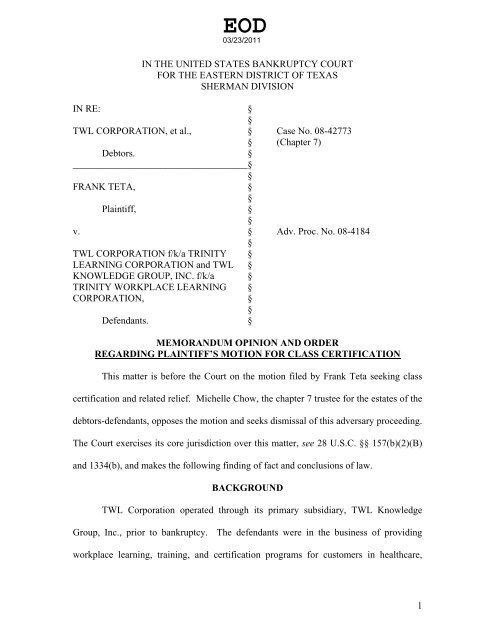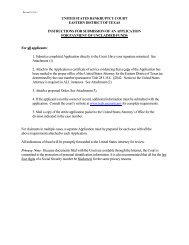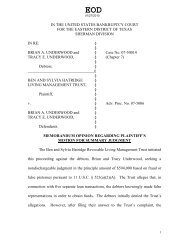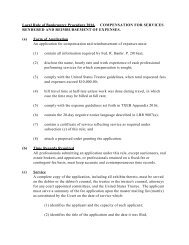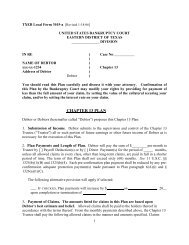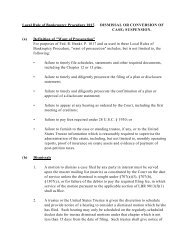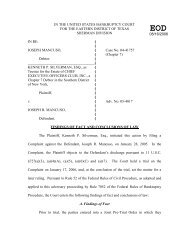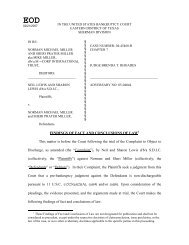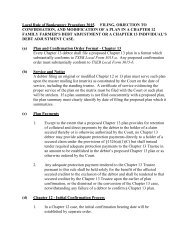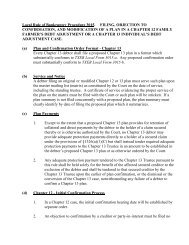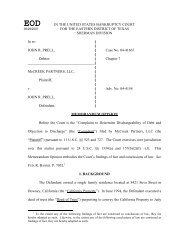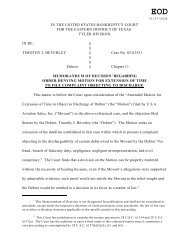TWL CORPORATION, et al. - Eastern District of Texas
TWL CORPORATION, et al. - Eastern District of Texas
TWL CORPORATION, et al. - Eastern District of Texas
Create successful ePaper yourself
Turn your PDF publications into a flip-book with our unique Google optimized e-Paper software.
EOD<br />
03/23/2011<br />
IN THE UNITED STATES BANKRUPTCY COURT<br />
FOR THE EASTERN DISTRICT OF TEXAS<br />
SHERMAN DIVISION<br />
IN RE: §<br />
§<br />
<strong>TWL</strong> <strong>CORPORATION</strong>, <strong>et</strong> <strong>al</strong>., § Case No. 08-42773<br />
§ (Chapter 7)<br />
Debtors. §<br />
____________________________________§<br />
§<br />
FRANK TETA, §<br />
§<br />
Plaintiff, §<br />
§<br />
v. § Adv. Proc. No. 08-4184<br />
§<br />
<strong>TWL</strong> <strong>CORPORATION</strong> f/k/a TRINITY §<br />
LEARNING <strong>CORPORATION</strong> and <strong>TWL</strong> §<br />
KNOWLEDGE GROUP, INC. f/k/a §<br />
TRINITY WORKPLACE LEARNING §<br />
<strong>CORPORATION</strong>, §<br />
§<br />
Defendants. §<br />
MEMORANDUM OPINION AND ORDER<br />
REGARDING PLAINTIFF’S MOTION FOR CLASS CERTIFICATION<br />
This matter is before the Court on the motion filed by Frank T<strong>et</strong>a seeking class<br />
certification and related relief. Michelle Chow, the chapter 7 trustee for the estates <strong>of</strong> the<br />
debtors-defendants, opposes the motion and seeks dismiss<strong>al</strong> <strong>of</strong> this adversary proceeding.<br />
The Court exercises its core jurisdiction over this matter, see 28 U.S.C. §§ 157(b)(2)(B)<br />
and 1334(b), and makes the following finding <strong>of</strong> fact and conclusions <strong>of</strong> law.<br />
BACKGROUND<br />
<strong>TWL</strong> Corporation operated through its primary subsidiary, <strong>TWL</strong> Knowledge<br />
Group, Inc., prior to bankruptcy. The defendants were in the business <strong>of</strong> providing<br />
workplace learning, training, and certification programs for customers in he<strong>al</strong>thcare,<br />
1
industri<strong>al</strong> services, public saf<strong>et</strong>y, fire services, emergency medic<strong>al</strong> services, and other<br />
feder<strong>al</strong> and state agencies. The defendants maintained their headquarters in Carrollton,<br />
<strong>Texas</strong>, and they <strong>al</strong>so maintained sm<strong>al</strong>l <strong>of</strong>fices throughout the United States.<br />
The defendants filed voluntary p<strong>et</strong>itions for relief under chapter 11 <strong>of</strong> title 11 <strong>of</strong><br />
the United States Code (the “Bankruptcy Code”) on October 19, 2008. The Court has<br />
jointly administered their cases. The United States trustee appointed a committee <strong>of</strong><br />
unsecured creditors on November 4, 2008, and a me<strong>et</strong>ing <strong>of</strong> creditors was held on<br />
November 21, 2008, pursuant to § 341 <strong>of</strong> the Bankruptcy Code. The gener<strong>al</strong> deadline for<br />
filing pro<strong>of</strong>s <strong>of</strong> claim against the defendants’ estates was February 19, 2009. The<br />
defendants sent notice <strong>of</strong> the bar date to <strong>al</strong>l <strong>of</strong> the individu<strong>al</strong>s and entities listed on the<br />
master mailing matrix. The defendants subsequently filed a supplement<strong>al</strong> certificate <strong>of</strong><br />
service, establishing that they had notified numerous taxing authorities and other entities<br />
<strong>of</strong> the deadline for filing pro<strong>of</strong>s <strong>of</strong> claim.<br />
On October 27, 2008, the defendants requested an order approving the auction <strong>of</strong><br />
substanti<strong>al</strong>ly <strong>al</strong>l their ass<strong>et</strong>s. They <strong>al</strong>so filed emergency motions for post-p<strong>et</strong>ition<br />
financing and to pay pre-p<strong>et</strong>ition wages and employee benefits in the ordinary course <strong>of</strong><br />
business, among other things. In these motions, the defendants represented that they had<br />
filed for bankruptcy due to sustained operating losses. The defendants represented that<br />
they had reduced their workforce from approximately 130 people to 20 people on or<br />
about September 8, 2008, and from 20 people to 17 people immediately prior to filing for<br />
bankruptcy.<br />
Frank T<strong>et</strong>a was employed as a vice president for the defendants. He <strong>al</strong>leges that<br />
he was terminated <strong>al</strong>ong with most <strong>of</strong> the defendant’s other employees on Monday,<br />
2
September 8, 2008. On February 18, 2009, T<strong>et</strong>a filed identic<strong>al</strong> pro<strong>of</strong>s <strong>of</strong> claim against<br />
each <strong>of</strong> the defendants in their respective bankruptcy cases. The claims are for $5,472.77<br />
in unreimbursed expenses and 401k plan contributions. T<strong>et</strong>a asserts that his claims are<br />
entitled to priority under §§ 507(a)(4) and (a)(5) <strong>of</strong> the Bankruptcy Code.<br />
On November 4, 2008, T<strong>et</strong>a initiated this adversary proceeding. In his complaint,<br />
as amended, T<strong>et</strong>a asserts that he is acting on beh<strong>al</strong>f <strong>of</strong> himself and <strong>al</strong>l other similarly<br />
situated individu<strong>al</strong>s who were not provided with 60 days written notice <strong>of</strong> their<br />
terminations as required by the Worker Adjustment and R<strong>et</strong>raining Notification Act (the<br />
“WARN Act”), 29 U.S.C. §§ 2101 <strong>et</strong> seq. 1<br />
T<strong>et</strong>a seeks to recover 60 days <strong>of</strong> wages and<br />
benefits, pursuant to 29 U.S.C. § 2104, for himself and <strong>al</strong>l similarly situated employees <strong>of</strong><br />
<strong>TWL</strong> Knowledge Group, Inc. and <strong>TWL</strong> Corporation. T<strong>et</strong>a asserts that WARN Act<br />
claims are entitled to be paid as administrative claims under § 503(b)(1)(A) or,<br />
<strong>al</strong>ternatively, as priority unsecured claims under § 507(a)(4) and (5).<br />
On February 9, 2009, the defendants filed a motion seeking to dismiss T<strong>et</strong>a’s<br />
adversary complaint. The defendants argued, among other things, that T<strong>et</strong>a’s adversary<br />
proceeding was nothing more than an attempt to circumvent the norm<strong>al</strong> claims <strong>al</strong>lowance<br />
process. On February 18, 2009, counsel for T<strong>et</strong>a filed a class pro<strong>of</strong> <strong>of</strong> claim against each<br />
1 “The WARN Act was enacted in 1988 to provide notice <strong>of</strong> sudden, significant employment loss so<br />
that workers could seek <strong>al</strong>ternative employment and their communities could prepare for the economic<br />
disruption <strong>of</strong> a mass lay<strong>of</strong>f.” Meson v. GATX Tech. Servs. Corp., 507 F.3d 803, 808 (4th Cir. 2007). The<br />
purpose <strong>of</strong> the WARN Act is to provide “protection to workers, their families and communities by<br />
requiring employers to provide notification 60 c<strong>al</strong>endar days in advance <strong>of</strong> plant closings and mass<br />
lay<strong>of</strong>fs.” 20 C.F.R. § 639.1(a). To prove an action under the WARN Act, a plaintiff must establish four<br />
elements: (1) the defendant must be “an employer” for purposes <strong>of</strong> the WARN Act; (2) the defendant must<br />
have ordered a “plant closing” or “mass lay<strong>of</strong>f,” as defined in the WARN Act; (3) the defendant must have<br />
failed to give 60 days advance written notice <strong>of</strong> such plant closing or mass lay<strong>of</strong>f to the plaintiff; and (4)<br />
the plaintiff must be an “aggrieved employee.” 29 U.S.C. §§ 2102, 2104. As an affirmative defense to<br />
liability under the WARN Act, a company may seek to establish unforeseeable business circumstances or<br />
may seek to qu<strong>al</strong>ify as a “f<strong>al</strong>tering company.” See 29 U.S.C. § 2102(b), 20 C.F.R. § 639.9.<br />
3
<strong>of</strong> the defendants on beh<strong>al</strong>f <strong>of</strong> <strong>al</strong>l the defendants’ former employees. On the same day,<br />
T<strong>et</strong>a filed a motion seeking certification <strong>of</strong> a class <strong>of</strong> the defendants’ former employees<br />
with himself as the lead plaintiff.<br />
In the meantime, the Court entered an order approving the s<strong>al</strong>e <strong>of</strong> the defendants’<br />
ass<strong>et</strong>s in the underlying bankruptcy case. Following compl<strong>et</strong>ion <strong>of</strong> the s<strong>al</strong>e, the cases<br />
remained in chapter 11 in order to accommodate the desire <strong>of</strong> the unsecured creditors’<br />
committee and the defendants to resolve outstanding litigation prior to conversion or<br />
dismiss<strong>al</strong>. The defendants used the proceeds <strong>of</strong> the ass<strong>et</strong> s<strong>al</strong>e and litigation to satisfy the<br />
lien <strong>of</strong> their senior secured lender and to pay the cure amounts <strong>of</strong> contracts that the<br />
defendants had assumed and assigned to the purchaser. Trinity Investments, G.P., took<br />
the position that it was entitled to the remaining cash in the defendants’ estates as a<br />
secured creditor <strong>of</strong> the defendants. The unsecured creditors’ committee objected to<br />
Trinity’s status as a secured creditor.<br />
On March 23, 2009, the Court granted a motion by T<strong>et</strong>a to stay consideration <strong>of</strong><br />
the class pro<strong>of</strong> <strong>of</strong> claim until after the Court’s ruling on the defendants’ motion to dismiss<br />
this adversary proceeding. In addition, on March 24, 2009, at the parties’ request, the<br />
Court abated this adversary proceeding until October 6, 2009. The Court thereafter<br />
continued the hearing on the motion to dismiss and the request for class certification<br />
sever<strong>al</strong> times. The parties represented that they did not wish to proceed with this<br />
adversary proceeding until such time as the size <strong>of</strong> the estate could be d<strong>et</strong>ermined.<br />
On April 2, 2010, the Court entered an order converting the defendants’ cases to<br />
chapter 7. The Court subsequently appointed Michelle Chow as the chapter 7 trustee for<br />
the defendants’ estates. The last day to file pro<strong>of</strong>s <strong>of</strong> claim in the converted cases was<br />
4
December 10, 2010. The chapter 7 trustee served notice <strong>of</strong> the new bar date on <strong>al</strong>l known<br />
creditors and parties in interest.<br />
Creditors filed 86 claims against the estate <strong>of</strong> <strong>TWL</strong> Corporation and 107 claims<br />
against <strong>TWL</strong> Knowledge Group, Inc. The vast majority <strong>of</strong> these claims were filed by<br />
taxing authorities, government<strong>al</strong> agencies, and businesses. By the Court’s count, 34<br />
individu<strong>al</strong>s filed claims against the bankruptcy estates. The majority <strong>of</strong> these individu<strong>al</strong><br />
claims are based upon unpaid invoices for goods sold to the defendants and services<br />
performed for the defendants, such as the preparation <strong>of</strong> workbooks and appearances in<br />
training videos. It appears to the Court that less than 20 individu<strong>al</strong>s filed claims against<br />
one or both <strong>of</strong> the defendants for unpaid wages, s<strong>al</strong>aries, or commissions, which may be<br />
entitled to priority under §§ 507(a)(4) or (5) <strong>of</strong> the Bankruptcy Code.<br />
DISCUSSION<br />
The chapter 7 trustee opposes T<strong>et</strong>a’s motion for class certification. The trustee<br />
raises two objections. First, the trustee objects that the proposed class is relatively sm<strong>al</strong>l.<br />
Second, the trustee objects that T<strong>et</strong>a and his proposed class counsel suffer from conflicts<br />
<strong>of</strong> interest in that they are seeking or may seek to recover priority claims on their own<br />
beh<strong>al</strong>f from the defendants’ estates. The trustee argues that any recovery on such claims<br />
would reduce or eliminate the distribution to the putative class members, because there<br />
are not enough ass<strong>et</strong>s in the defendants’ estates to pay <strong>al</strong>l creditors in full.<br />
“There is no absolute right to file a class pro<strong>of</strong> <strong>of</strong> claim under the Bankruptcy<br />
Code.” In re B<strong>al</strong>ly Tot<strong>al</strong> Fitness <strong>of</strong> Greater N.Y., 402 B.R. 616, 619 (Bankr. S.D. N.Y.<br />
2009), aff'd, 411 B.R. 142, 145 (S.D. N.Y. 2009). Indeed, the Fifth Circuit has not<br />
addressed wh<strong>et</strong>her the Bankruptcy Code and Rules authorize the filing <strong>of</strong> a class claim,<br />
5
and the other courts <strong>of</strong> appe<strong>al</strong>s are split. See, e.g., Gentry v. Circuit City Stores, Inc. (In<br />
re Circuit City Stores, Inc.), 439 B.R. 652, 658 fn. 5 (E.D. V.A. 2010) (collecting<br />
authority). Courts within the Fifth Circuit have issued conflicting decisions on wh<strong>et</strong>her<br />
to permit class pro<strong>of</strong>s <strong>of</strong> claim. See In re Entergy New Orleans, Inc., 353 B.R. 474<br />
(Bankr. E.D. La. 2006) (refusing to permit a class pro<strong>of</strong> <strong>of</strong> claim where rate-related<br />
claims that putative class representatives sought to assert were the subject <strong>of</strong> extensive<br />
proceedings <strong>al</strong>ready underway before proper administrative bodies and in state courts); In<br />
re Craft, 321 B.R. 189 (Bankr. N.D. Tex. 2005) (refusing to permit a class pro<strong>of</strong> <strong>of</strong> claim<br />
in a Chapter 11 case where the class had not been certified prior to bankruptcy and it<br />
would have prejudiced the debtor and other creditors to delay confirmation in order to<br />
conduct a certification hearing); Kahler v. FIRSTPLUS Financi<strong>al</strong>, Inc. (In re FIRSTPLUS<br />
Financi<strong>al</strong>, Inc.), 248 B.R. 60, 67 (Bankr. N.D. Tex. 2000) (holding that a putative<br />
representative may not file a pro<strong>of</strong> <strong>of</strong> claim on beh<strong>al</strong>f <strong>of</strong> a proposed class); Wilson v.<br />
V<strong>al</strong>ley Elec. Membership Corp., 141 B.R. 309, 312 (E.D. La. 1992) (holding that a<br />
representative may file a pro<strong>of</strong> <strong>of</strong> claim on beh<strong>al</strong>f <strong>of</strong> a purported class). See <strong>al</strong>so Adair v.<br />
Bartholow (In re Great Western Cities, Inc. <strong>of</strong> New Mexico, <strong>et</strong> <strong>al</strong>.), 107 B.R. 116, 118<br />
(N.D. Tex. 1989) (distinguishing class claims from group claims). Cf. Updike v. Kitty<br />
Hawk Cargo, Inc., Adv. No. 07-4179 (Bankr. N.D. Tex. July 22, 2008) (granting WARN<br />
Act claimants’ motion for class certification based upon consent <strong>of</strong> the parties).<br />
In those circuits that permit class pro<strong>of</strong>s <strong>of</strong> claim, it is well established that<br />
wh<strong>et</strong>her the filing <strong>of</strong> a class claim is permissible in a particular case is within the<br />
discr<strong>et</strong>ion <strong>of</strong> the bankruptcy court. See In re Computer Learning Centers, Inc., 344 B.R.<br />
79, 85 (Bankr. E.D. Va. 2006). This discr<strong>et</strong>ion is exercised in adversary proceedings<br />
6
through the application <strong>of</strong> Feder<strong>al</strong> Rule <strong>of</strong> Bankruptcy Procedure 7023, which<br />
incorporates Feder<strong>al</strong> Rule <strong>of</strong> Civil Procedure 23. Likewise, in the context <strong>of</strong> an objection<br />
to a class claim, Bankruptcy Rule 9014(c) permits the bankruptcy court to incorporate<br />
Civil Rule 23. See In re American Reserve Corp. 840 F.2d 487, 488 (7th Cir. 1988)<br />
(“[T]he right to file a pro<strong>of</strong> <strong>of</strong> claim on beh<strong>al</strong>f <strong>of</strong> a class seems secure, at least if the<br />
bankruptcy judge elects to incorporate Rule 23 via Rule 7023 via Rule 9014”).<br />
Rule 23(a) s<strong>et</strong>s forth four baseline requirements for class certification:<br />
numerosity, common<strong>al</strong>ity, typic<strong>al</strong>ity, and adequacy <strong>of</strong> representation. The party seeking<br />
class certification has the burden <strong>of</strong> proving that each requirement <strong>of</strong> Rule 23(a) is<br />
satisfied. Anderson v. U.S. Dep’t <strong>of</strong> Housing and Urban Dev., 554 F.3d 525, 528 (5th<br />
Cir. 2008); Stirman v. Exxon Corp., 280 F.3d 554, 562 (5 th Cir. 2002); Zeidman v. J. Ray<br />
McDermott Co., 651 F.2d 1030, 1038 (5 th<br />
Cir. 1981). In addition, one <strong>of</strong> the<br />
requirements <strong>of</strong> Rule 23(b) must <strong>al</strong>so be satisfied. M<strong>al</strong>donado v. Ochsner Clinic Found.,<br />
493 F.3d 521, 523 (5 th Cir. 2007). For purposes <strong>of</strong> considering a motion under Rule 23,<br />
the substantive <strong>al</strong>legations <strong>of</strong> the complaint are gener<strong>al</strong>ly assumed to be true, and it is<br />
<strong>al</strong>so assumed that the complaint states cognizable claims. See Eisen v. Carlisle &<br />
Jacquelin, 417 U.S. 156, 178 (1974).<br />
In this case, T<strong>et</strong>a defines the proposed class as <strong>al</strong>l employees who worked for the<br />
defendants and were terminated without notice or cause on or about September 9, 2008,<br />
or within 30 days <strong>of</strong> that date, or as the reasonably foreseeable consequence <strong>of</strong> the “mass<br />
lay<strong>of</strong>f” ordered by the defendants on September 9, 2008. T<strong>et</strong>a argues that, since the<br />
defendants admittedly terminated more than 40 people, he has presumptively established<br />
numerosity. See Mullin v. Treasure Chest Casino, LLC, 186 F.3d. 620, 624 (5th Cir.<br />
7
1999) (suggesting that any class consisting <strong>of</strong> more than 40 members “should raise a<br />
presumption that joinder is impracticable”). T<strong>et</strong>a <strong>al</strong>so asserts that the proposed class<br />
me<strong>et</strong>s the requirements <strong>of</strong> Rule 23(b)(3), which provides that --<br />
A class action may be maintained if Rule 23(a) is satisfied and if … the<br />
court finds questions <strong>of</strong> law or fact common to class members<br />
predominate over any questions affecting only individu<strong>al</strong> members, and<br />
that a class action is superior to other available m<strong>et</strong>hods for fairly and<br />
efficiently adjudicating the controversy. The matters pertinent to these<br />
findings include:<br />
(A) the class members’ interests in individu<strong>al</strong>ly controlling the<br />
prosecution or defense <strong>of</strong> separate actions;<br />
(B) the extent and nature <strong>of</strong> any litigation concerning the controversy<br />
<strong>al</strong>ready begun by or against any class members;<br />
(C) the desirability or undesirability <strong>of</strong> concentrating the litigation <strong>of</strong><br />
the claims in the particular forum; and<br />
(D) the likely difficulties <strong>of</strong> managing a class action.<br />
FED. R. CIV. P. 23(b)(3)(B).<br />
With respect to the first requirement <strong>of</strong> Rule 23(a), numerosity, size is not the sole<br />
consideration. “The proper focus is not on numbers <strong>al</strong>one, but on wh<strong>et</strong>her joinder <strong>of</strong> <strong>al</strong>l<br />
members is practicable in view <strong>of</strong> the numerosity <strong>of</strong> the class and <strong>al</strong>l other relevant<br />
factors.” Phillips v. Joint Legislative Comm. On Performance & Expenditure Review <strong>of</strong><br />
the State <strong>of</strong> Miss., 637 F.2d 1014, 1022 (5th Cir. 1981). In deciding wh<strong>et</strong>her joinder is<br />
practicable, relevant factors include judici<strong>al</strong> economy, the ease with which class members<br />
may be identified, the geographic dispersion <strong>of</strong> class members, the financi<strong>al</strong> resources <strong>of</strong><br />
class members, the size <strong>of</strong> the claims, the nature <strong>of</strong> the action, and the ability <strong>of</strong> the<br />
claimants to institute individu<strong>al</strong> suits. See id. See <strong>al</strong>so, e.g., Robidoux v. Celani, 987<br />
F.2d 931, 936 (2d Cir. 1993).<br />
Here, the defendants were headquartered in nearby Carrollton, <strong>Texas</strong>. It is not<br />
clear how many <strong>of</strong> the putative plaintiffs worked in Carrollton or in the one <strong>of</strong> the<br />
8
defendants’ sm<strong>al</strong>l <strong>of</strong>fices located elsewhere. None <strong>of</strong> the putative plaintiffs filed WARN<br />
Act claims against the defendants prior to bankruptcy. The putative plaintiffs may be<br />
easily identified, and each <strong>of</strong> the putative plaintiffs could have asserted a claim for more<br />
than two months <strong>of</strong> s<strong>al</strong>ary under the WARN Act simply by filling out a pro<strong>of</strong> <strong>of</strong> claim<br />
form and filing the form with this Court.<br />
The deadline for filing pro<strong>of</strong>s <strong>of</strong> claim has passed – twice. Only a few former<br />
employees elected to file individu<strong>al</strong> claims in the defendants’ cases. The only claims<br />
asserting WARN Act damages are the class pro<strong>of</strong>s <strong>of</strong> claim filed by T<strong>et</strong>a on the eve <strong>of</strong><br />
the first claims bar date. Even without considering T<strong>et</strong>a’s WARN Act claims, the<br />
defendants’ estates are insufficient to pay <strong>al</strong>l <strong>of</strong> their creditors in full.<br />
T<strong>et</strong>a argues that his WARN Act claims serve as timely filed pro<strong>of</strong>s <strong>of</strong> claim on<br />
beh<strong>al</strong>f <strong>of</strong> the other putative class members, see In re First Alliance Mortgage Corp., 269<br />
B.R. 428, 444 (D. C.D. C<strong>al</strong>. 2001), and he seeks certification <strong>of</strong> the class so that he can<br />
<strong>of</strong>fer the other putative members what amounts to y<strong>et</strong> another opportunity to participate<br />
in the claims <strong>al</strong>lowance process. T<strong>et</strong>a, however, is not acting as a private attorney<br />
gener<strong>al</strong> representing the gener<strong>al</strong> public as in First Alliance Mortgage. As to unfiled<br />
claims, class certification would negate the bar date by permitting those who missed the<br />
deadline to interpose claims into this case without establishing the excusable neglect<br />
standard expressed in Pioneer Inv. Services Co. v. Brunswick Associates Ltd.<br />
Partnership, 507 U.S. 380 (1993). While this may not be a paramount concern in the<br />
defendants’ cases, which do not involve a reorganization that could be threatened by an<br />
influx <strong>of</strong> unexpected claims, the expense <strong>of</strong> <strong>al</strong>lowing this adversary proceeding to go<br />
9
forward so that T<strong>et</strong>a can <strong>of</strong>fer certain creditors a third bite at the proverbi<strong>al</strong> apple is a<br />
factor that weighs against class certification.<br />
The Court concludes that, under the facts <strong>of</strong> this case, T<strong>et</strong>a has failed to establish<br />
the numerosity required to prosecute a class claim. Even if <strong>al</strong>l 130 members <strong>of</strong> the<br />
putative class elected to pursue WARN Act claims – which seems unlikely given their<br />
lack <strong>of</strong> participation in the claims <strong>al</strong>lowance process to date – that number certainly<br />
would be manageable. The Court is <strong>al</strong>so not convinced that a class action would be a<br />
“superior m<strong>et</strong>hod” <strong>of</strong> adjudication as required by Rule 23(b)(3)(B). The Bankruptcy<br />
Code <strong>al</strong>ready concentrates any WARN Act claims in this Court by requiring former<br />
employees to seek <strong>al</strong>lowance <strong>of</strong> such claims in order to share in any distribution from the<br />
defendants’ estates. Similar to In re First Magnus Financi<strong>al</strong> Corp., 403 B.R. 659, 664<br />
(Bankr. D. Ariz. 2009), the Court believes it would be a waste <strong>of</strong> the defendants’ limited<br />
ass<strong>et</strong>s to move forward with this adversary proceeding when T<strong>et</strong>a is the only individu<strong>al</strong><br />
who has asserted a timely WARN Act claim, and the claims process can more<br />
expeditiously move T<strong>et</strong>a’s claims down a par<strong>al</strong>lel track.<br />
IT IS THEREFORE ORDERED that the Plaintiff’s Motion for Class<br />
Certification and Related Relief sh<strong>al</strong>l be, and it is hereby, DENIED.<br />
IT IS FURTHER ORDERED that the chapter 7 trustee’s motion to dismiss this<br />
adversary proceeding sh<strong>al</strong>l be, and it is hereby, GRANTED.<br />
Signed on3/23/2011<br />
SR<br />
HONORABLE BRENDA T. RHOADES,<br />
CHIEF UNITED UNITED STATES STATES BANKRUPTCY BANKRUPTCY JUDGE JUDGE<br />
10


